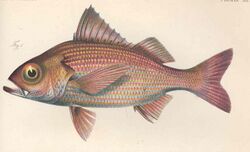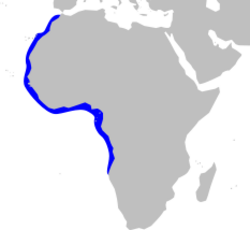Biology:Bigeye grunt
| Bigeye grunt | |
|---|---|

| |
| Scientific classification | |
| Domain: | Eukaryota |
| Kingdom: | Animalia |
| Phylum: | Chordata |
| Class: | Actinopterygii |
| Order: | Perciformes |
| Family: | Haemulidae |
| Subfamily: | Haemulinae |
| Genus: | Brachydeuterus T. N. Gill, 1862 |
| Species: | B. auritus
|
| Binomial name | |
| Brachydeuterus auritus (Valenciennes, 1832)
| |

| |
| Range of Brachydeuterus auritus | |
| Synonyms[2][3] | |
|
Genus
Species
| |
The bigeye grunt (Brachydeuterus auritus) is a species of marine ray-finned fish, a grunt belonging to the family Haemulidae. It is native to the Atlantic coast of Africa.
Description
The bigeye grunt has an oblong, somewhat compressed body with a large eye, a snoutwhich is shorter than the diameter of its eye and a large, protrusible mouth chin It has a deeply notched dorsal fin which contains 10-13 spines, with the 3rd spine (also occasionally the 4th) being the longest. The anal fin has 3 spines and 9-10, infrequently 8, soft rays. The caudal fin is deeply emarginate. The back is olive and the flanks and abdomen are silvery to white. There is a dark blotch on upper edge of the gill cover and there are small dark spots on the base of the dorsal fin, although these are not always present.[4] This species attains a maximum total length of 30 cm (12 in), although 23 cm (9.1 in) is more typical.[2]
Distribution
The bigeye grunt is found in the eastern Atlantic Ocean where it occurs along the western coast of Africa from Morocco to Angola, although it is most common from Senegal south.[1]
Habitat and biology
The bigeye grunt is found at depths between 10 and 150 m (33 and 492 ft).[1] It can be found on Sandy and muddy substrates, moving up the water column to feed near the surface during the night. It feeds on small fish and invertebrates.[5] This species may spawn throughout the year, becoming sexually mature at around 8 months old for males and 12 months for females, but there may be two peaks in spawning coinciding with the timing of upwellings.[1]
Systematics
The bigeye grunt was first formally described in 1832 as Larimus auritus by the French zoologist Achille Valenciennes 1794-1865) with the type locality given as Gorée in Senegal.[6] It is the only species in the monotypic genus Brachydeuterus.[7] The generic name is a compound of brachy meaning “short” and deuterus meaning “second”, a reference to the lower Sony rayed part of the dorsal fin which is almost separated from the anterior spiny part by a deep notch. The specific name auritus means “eared” and is areference to the blotch on the gill cover.[8]
Utilisation
The bigeye grunt is commercially important in many parts of West Africa,[1] especially Ghana and Côte d’Ivoire. They are caught using bottom trawls, gill nets, set nets and push seines. They are sold fresh, smoked it processed into fish meal.[4] it has also been used to make dish crackers when it’s flesh is mixed with cassava.[1]
References
- ↑ 1.0 1.1 1.2 1.3 1.4 1.5 de Morais, L.; Sidibé, A.; Sylla, M.; Camara, K.; Carpenter, K.E.; Djiman, R.; Nunoo, F.; Sagna, A. et al. (2015). "Brachydeuterus auritus". IUCN Red List of Threatened Species 2015: e.T194413A2333329. doi:10.2305/IUCN.UK.2015-4.RLTS.T194413A2333329.en. https://www.iucnredlist.org/species/194413/2333329. Retrieved 19 November 2021.
- ↑ 2.0 2.1 Froese, Rainer and Pauly, Daniel, eds. (2019). "Brachydeuterus auritus" in FishBase. December 2019 version.
- ↑ Eschmeyer, William N.; Fricke, Ron; van der Laan, Richard, eds. "Genera in the family Haemulidae". California Academy of Sciences. http://researcharchive.calacademy.org/research/ichthyology/catalog/fishcatget.asp?tbl=genus&family=Haemulidae.
- ↑ 4.0 4.1 "Species Fact Sheets Brachydeuterus auritus". FAO. http://www.fao.org/fishery/species/3147/en. Retrieved 25 March 2021.
- ↑ J.C. Hureau. "Bigeye grunt (Brachydeuterus auritus)". Marine Species Identification Portal - Fishes of the NE Atlantic and Mediterranean. ETI Bioinformatics. http://species-identification.org/species.php?species_group=fnam&id=1812.
- ↑ Eschmeyer, William N.; Fricke, Ron; van der Laan, Richard, eds. "Species in the genus Brachydeuterus". California Academy of Sciences. http://researcharchive.calacademy.org/research/ichthyology/catalog/fishcatget.asp?tbl=species&genus=Brachydeuterus.
- ↑ Froese, Rainer and Pauly, Daniel, eds. (2006). Species of Brachydeuterus in FishBase. April 2006 version.
- ↑ Christopher Scharpf; Kenneth J. Lazara, eds (5 January 2021). "Order LUTJANIFORMES: Families HAEMULIDAE and LUTJANIDAE". The ETYFish Project Fish Name Etymology Database. Christopher Scharpf and Kenneth J. Lazara. https://etyfish.org/lutjaniformes/. Retrieved 23 March 2021.
Wikidata ☰ Q2291766 entry
 |


